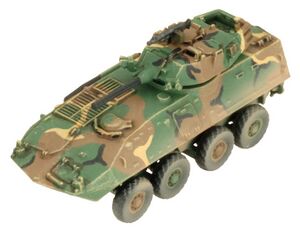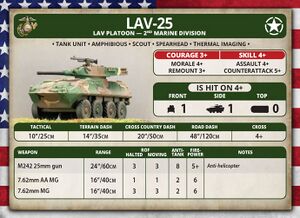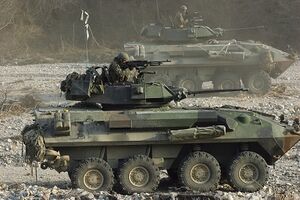LAV-25: Difference between revisions
1d4chan>Catnip212 |
1d4chan>Ralph Waldo Picklechips |
||
| Line 16: | Line 16: | ||
The LAV-25 is an infantry fighting vehicle used by the US Marines Corps for reconnaissance and light fire support. If it wasn’t for the fact that it’s primarily designated for recon rather than transportation, you would classify this as a proper Infantry Fighting Vehicle, as it sports a mean 25mm autocannon in addition to the real life 6 man passenger capacity; enough for a fireteam of Marines with equipment. Despite its respectable firepower, it’s armor is still weak against anything more serious than small arms (later versions can protect against up to 14.5mm rounds and slat armor add-one protect against shape charges). The idea of having IFVs with truly effective armor would only become widespread later on in the 21st Century with the push to vehicles capable of surviving in an urban environment, birthing designs like the MRAP. In the Army, the role of the IFV is to support infantry in open ground against tanks and vehicles, hence the increased armor and ATGMs. The role of the Marines as a rapid reaction force forced them to compromise the slugging power of the Bradley for speed and transportability, essential for establishing a naval beachhead. | The LAV-25 is an infantry fighting vehicle used by the US Marines Corps for reconnaissance and light fire support. If it wasn’t for the fact that it’s primarily designated for recon rather than transportation, you would classify this as a proper Infantry Fighting Vehicle, as it sports a mean 25mm autocannon in addition to the real life 6 man passenger capacity; enough for a fireteam of Marines with equipment. Despite its respectable firepower, it’s armor is still weak against anything more serious than small arms (later versions can protect against up to 14.5mm rounds and slat armor add-one protect against shape charges). The idea of having IFVs with truly effective armor would only become widespread later on in the 21st Century with the push to vehicles capable of surviving in an urban environment, birthing designs like the MRAP. In the Army, the role of the IFV is to support infantry in open ground against tanks and vehicles, hence the increased armor and ATGMs. The role of the Marines as a rapid reaction force forced them to compromise the slugging power of the Bradley for speed and transportability, essential for establishing a naval beachhead. | ||
The LAV-25 has many variants that used by the Marines Corps, some represented in Team Yankee ([[LAV-AT]], [[LAV-M]]), and some that are not (LAV-AD, which was basically like a hybrid of the [[M163 VADS]] and [[M48 Chaparral]] but was retired due to budget constraints. The US Army uses their own version of the MOWAG Piranha, the advanced Stryker. Although that variant was only armed with a machine gun (and possibly a 40mm grenade launcher) until recently and wasn’t adopted until more or less a decade after the Cold War. Other Stryker variants match LAV variants, with the exception of the M1128 MGS which mounts a 105mm cannon. | The LAV-25 has many variants that used by the Marines Corps, some represented in Team Yankee ([[LAV-AT]], [[LAV-M]]), and some that are not (LAV-AD, which was basically like a hybrid of the [[M163 VADS]] and [[M48 Chaparral]] but was retired due to budget constraints. The US Army uses their own version of the MOWAG Piranha, the advanced Stryker. Although that variant was only armed with a machine gun (and possibly a 40mm grenade launcher) until recently and wasn’t adopted until more or less a decade after the Cold War. Other Stryker variants match LAV variants, with the exception of the M1128 MGS which mounts a 105mm cannon (making it the US equivalent to the [[AMX-10 RC]]). | ||
As for future replacements, well there isn't any. With all the new concepts that the American military-industrial complex is turning out. Anything demonstrated to replace the Piranha variants can probably be counted on one hand. In all likelihood, a future replacement will be based on another armored wheeled vehicle used by America's allies or a derivative of the Piranha V. | As for future replacements, well there isn't any. With all the new concepts that the American military-industrial complex is turning out. Anything demonstrated to replace the Piranha variants can probably be counted on one hand. In all likelihood, a future replacement will be based on another armored wheeled vehicle used by America's allies or a derivative of the Piranha V. | ||
{{US Forces in Team Yankee}} | {{US Forces in Team Yankee}} | ||
Revision as of 18:37, 30 September 2018

The Light Armored Vehicle-25 (or LAV-25 for short) is an 8-wheeled amphibious recon vehicle, manufactured by GMC Canada. In America, its one of the USMC's premier infantry fighting vehicles, whose speed and amphibious nature, plus its decent weaponry, lent well to the Marines' tactics as forward vanguards.
The vehicle is crewed by 3 people: a commander, gunner, and driver, plus it can also transport 4 fully-geared soldiers who are there to act as scouts, or to assist the LAV with dealing with targets that they are not equipped to handle (such as armored tanks, although that's only if someone decided to bring an AT weapon). The vehicle's default armament is an M242 25mm chain gun, plus two M240 7.62mm machine guns, one of which is mounted co-axial with the chain gun, and one at the top of the turret.
In Team Yankee

As an infantry fighting vehicle toting an autocannon, the LAV excels in maneuver warfare against lightly armored forces. With a moving ROF of 3 and a AT8, it can comfortably destroy pretty much anything apart from main battle tanks through weight of fire. With anti-helicopter, it can even engage Hinds from a range of 24" albeit with penalties above 16" (which would probably not be a problem with the PACT's short ranged helicopters). However, their paper-thin armor means that these glass cannons will die in droves if hammered by artillery, infantry or anything bigger than a rifle cartridge. Even BTRs can overwhelm an LAV platoon with their HMG rounds posing a serious threat.
Consider using the LAV as a flanking force to divert the enemy away from your main thrust. With their powerful guns, a group of LAVs can wreak havoc on high value, rear-echelon units like artillery pieces and spotters. Alternatively, they may be used as a mobile reserve to protect gaps in your line. Do not expect them to hold however: they lack the fanatical morale of the Soviets or the survivability of M113s.
IRL

The LAV-25 is an infantry fighting vehicle used by the US Marines Corps for reconnaissance and light fire support. If it wasn’t for the fact that it’s primarily designated for recon rather than transportation, you would classify this as a proper Infantry Fighting Vehicle, as it sports a mean 25mm autocannon in addition to the real life 6 man passenger capacity; enough for a fireteam of Marines with equipment. Despite its respectable firepower, it’s armor is still weak against anything more serious than small arms (later versions can protect against up to 14.5mm rounds and slat armor add-one protect against shape charges). The idea of having IFVs with truly effective armor would only become widespread later on in the 21st Century with the push to vehicles capable of surviving in an urban environment, birthing designs like the MRAP. In the Army, the role of the IFV is to support infantry in open ground against tanks and vehicles, hence the increased armor and ATGMs. The role of the Marines as a rapid reaction force forced them to compromise the slugging power of the Bradley for speed and transportability, essential for establishing a naval beachhead.
The LAV-25 has many variants that used by the Marines Corps, some represented in Team Yankee (LAV-AT, LAV-M), and some that are not (LAV-AD, which was basically like a hybrid of the M163 VADS and M48 Chaparral but was retired due to budget constraints. The US Army uses their own version of the MOWAG Piranha, the advanced Stryker. Although that variant was only armed with a machine gun (and possibly a 40mm grenade launcher) until recently and wasn’t adopted until more or less a decade after the Cold War. Other Stryker variants match LAV variants, with the exception of the M1128 MGS which mounts a 105mm cannon (making it the US equivalent to the AMX-10 RC).
As for future replacements, well there isn't any. With all the new concepts that the American military-industrial complex is turning out. Anything demonstrated to replace the Piranha variants can probably be counted on one hand. In all likelihood, a future replacement will be based on another armored wheeled vehicle used by America's allies or a derivative of the Piranha V.
| US Forces in Team Yankee | |
|---|---|
| Tanks: | M1 Abrams - M60 Patton - M551 Sheridan - RDF/LT |
| Transports: | M113 Armored Personnel Carrier - UH-1 Huey - AAVP7 - Bradley Fighting Vehicle - Pickup Trucks |
| Troops: | US Mech Platoon - Marine Rifle Platoon - Huey Rifle Platoon - HMMWV Machine Gun Platoon - Light Motor Infantry Platoon - Irregular Militia Group |
| Artillery: | M106 Heavy Mortar Carrier - M109 Howitzer - LAV-M - M270 MLRS |
| Anti-Aircraft: | M163 VADS - M48 Chaparral - M247 Sergeant York - HMMWV SAM |
| Tank Hunters: | M901 ITV - HMMWV-TOW - LAV-AT |
| Recon: | M113 FIST- M113 Scout Section - HMMWV Scout Section - LAV-25 - Bradley Fighting Vehicle |
| Aircraft: | A-10 Warthog - AV-8 Harrier - AH-1 Cobra Attack Helicopter - AH-64 Apache Attack Helicopter |